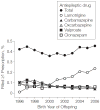Prenatal valproate exposure and risk of autism spectrum disorders and childhood autism
- PMID: 23613074
- PMCID: PMC4511955
- DOI: 10.1001/jama.2013.2270
Prenatal valproate exposure and risk of autism spectrum disorders and childhood autism
Abstract
Importance: Valproate is used for the treatment of epilepsy and other neuropsychological disorders and may be the only treatment option for women of childbearing potential. However, prenatal exposure to valproate may increase the risk of autism.
Objective: To determine whether prenatal exposure to valproate is associated with an increased risk of autism in offspring.
Design, setting, and participants: Population-based study of all children born alive in Denmark from 1996 to 2006. National registers were used to identify children exposed to valproate during pregnancy and diagnosed with autism spectrum disorders (childhood autism [autistic disorder], Asperger syndrome, atypical autism, and other or unspecified pervasive developmental disorders). We analyzed the risks associated with all autism spectrum disorders as well as childhood autism. Data were analyzed by Cox regression adjusting for potential confounders (maternal age at conception, paternal age at conception, parental psychiatric history, gestational age, birth weight, sex, congenital malformations, and parity). Children were followed up from birth until the day of autism spectrum disorder diagnosis, death, emigration, or December 31, 2010, whichever came first.
Main outcomes and measures: Absolute risk (cumulative incidence) and the hazard ratio (HR) of autism spectrum disorder and childhood autism in children after exposure to valproate in pregnancy.
Results: Of 655,615 children born from 1996 through 2006, 5437 were identified with autism spectrum disorder, including 2067 with childhood autism. The mean age of the children at end of follow-up was 8.84 years (range, 4-14; median, 8.85). The estimated absolute risk after 14 years of follow-up was 1.53% (95% CI, 1.47%-1.58%) for autism spectrum disorder and 0.48% (95% CI, 0.46%-0.51%) for childhood autism. Overall, the 508 children exposed to valproate had an absolute risk of 4.42% (95% CI, 2.59%-7.46%) for autism spectrum disorder (adjusted HR, 2.9 [95% CI, 1.7-4.9]) and an absolute risk of 2.50% (95% CI, 1.30%-4.81%) for childhood autism (adjusted HR, 5.2 [95% CI, 2.7-10.0]). When restricting the cohort to the 6584 children born to women with epilepsy, the absolute risk of autism spectrum disorder among 432 children exposed to valproate was 4.15% (95% CI, 2.20%-7.81%) (adjusted HR, 1.7 [95% CI, 0.9-3.2]), and the absolute risk of childhood autism was 2.95% (95% CI, 1.42%-6.11%) (adjusted HR, 2.9 [95% CI, 1.4-6.0]) vs 2.44% (95% CI, 1.88%-3.16%) for autism spectrum disorder and 1.02% (95% CI, 0.70%-1.49%) for childhood autism among 6152 children not exposed to valproate.
Conclusions and relevance: Maternal use of valproate during pregnancy was associated with a significantly increased risk of autism spectrum disorder and childhood autism in the offspring, even after adjusting for maternal epilepsy. For women of childbearing potential who use antiepileptic medications, these findings must be balanced against the treatment benefits for women who require valproate for epilepsy control.
Conflict of interest statement
Figures


Comment in
-
Risks of in utero exposure to valproate.JAMA. 2013 Apr 24;309(16):1730-1. doi: 10.1001/jama.2013.4001. JAMA. 2013. PMID: 23613078 Free PMC article. No abstract available.
-
Prenatal valproate exposure is associated with autism spectrum disorder and childhood autism.J Pediatr. 2013 Sep;163(3):924. doi: 10.1016/j.jpeds.2013.06.050. J Pediatr. 2013. PMID: 23973243 Free PMC article. No abstract available.
-
Prenatal exposure to sodium valproate is associated with increased risk of childhood autism and autistic spectrum disorder.Evid Based Nurs. 2014 Jul;17(3):84. doi: 10.1136/eb-2013-101422. Epub 2013 Sep 2. Evid Based Nurs. 2014. PMID: 23999195 No abstract available.
-
Valproate use during pregnancy was linked to autism spectrum disorder and childhood autism in offspring.Ann Intern Med. 2013 Aug 20;159(4):JC13. doi: 10.7326/0003-4819-159-4-201308200-02013. Ann Intern Med. 2013. PMID: 24026277 No abstract available.
-
Prenatal valproate exposure and risk of autism spectrum disorders and childhood autism.Arch Dis Child Educ Pract Ed. 2014 Oct;99(5):198. doi: 10.1136/archdischild-2013-305636. Epub 2014 Apr 1. Arch Dis Child Educ Pract Ed. 2014. PMID: 24692263 No abstract available.
References
-
- Holmes GL, Harden C, Liporace J, Gordon J. Postnatal concerns in children born to women with epilepsy. Epilepsy Behav. 2007;11(3):270–276. - PubMed
-
- Rasalam AD, Hailey H, Williams JH, et al. Characteristics of fetal anticonvulsant syndrome associated autistic disorder. Dev Med Child Neurol. 2005;47(8):551–555. - PubMed
Publication types
MeSH terms
Substances
Grants and funding
LinkOut - more resources
Full Text Sources
Other Literature Sources
Medical

